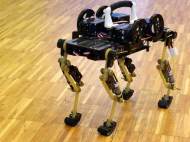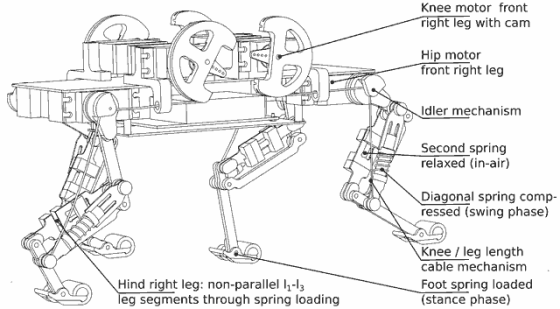Cheetah-cub robot – light, fast, robust and affordable feline inspired platform
 Researchers at the EPFL have developed a bioinspired robotic platform whose purpose is to encourage research in biomechanics. The four-legged “cheetah-cub robot” is small and light, and the design of legs, whose design faithfully reproduces feline morphology, make it fast and stable. Robots developed from this concept could eventually be used in search and rescue missions or for exploration.
Researchers at the EPFL have developed a bioinspired robotic platform whose purpose is to encourage research in biomechanics. The four-legged “cheetah-cub robot” is small and light, and the design of legs, whose design faithfully reproduces feline morphology, make it fast and stable. Robots developed from this concept could eventually be used in search and rescue missions or for exploration.
Developed by EPFL’s Biorobotics Laboratory (Biorob), the small-size quadruped prototype robot doesn’t have a head, but its movement and overall design can still reminiscent of a feline. The robot weights 1kg (2.2 pounds) and is approximately 21cm (8.28 inches) long.
Relying on a blueprint of a researcher who suggested that many quadrupedal, mammalian animals feature a distinguished functional three-segment front leg and hind leg design, and proposed a “pantograph” leg abstraction for robotic research, EPFL researchers designed, implemented, and tested two variations of such a pantograph leg design.
Both implementations make use of in-parallel leg elasticity, through leg springs integrated in the pantograph and the robot’s feet. The robot’s 15cm (5.9-inch) long legs have passive response of mechanical springs which has shown to be a good approximation of the muscle-tendon complex in animal legs and humans. The robot’s legs are each actuated by two powerful RC servo motors, moving hip and knee joints.
“This morphology gives the robot the mechanical properties from which cats benefit, that’s to say a marked running ability and elasticity in the right spots, to ensure stability”, said Alexander Sprowitz, a Biorob scientist. “The robot is thus naturally more autonomous.”
Still in its experimental stage, the robot will serve as a platform for research in locomotion and biomechanics. Although not quite as agile as a real cat, it still has excellent auto-stabilization characteristics when running at full speed or over a course that included disturbances such as small steps.
According to EPFL researchers, this robot is the fastest in its category, namely in normalized speed for small quadruped robots under 30kg. During tests, it demonstrated its ability to run at 1.42m/s (3.2 mph), almost seven body lengths per second.
Work with Cheetah-cub is also a continuation of work at the Biorobotics laboratory researching central pattern generators (CPGs) – networks of coupled neurons. CPGs are sophisticated circuits that can produce complex movement patterns while receiving only simple command signals from upper parts of the brain.
Cheetah-cub robot has several interesting features, especially when compared to larger and stiffer quadruped robot designs. It shows self-stabilizing behavior over a large range of speeds with open loop control. Aside being extremely lightweight, compact, and robust, the robot can be easily assembled from materials that are inexpensive and readily available. It is electrically powered and safe to handle, making it an excellent platform for research of multi-segment legs in quadruped robots.
For more information, read the article published in The International Journal of Robotics Research: “Towards Dynamic Trot Gait Locomotion-Design, Control and Experiments with Cheetah-cub, a Compliant Quadruped Robot” [2.69MB draft version PDF].










Leave your response!